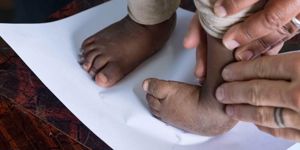Clubfoot: what is it and is it treatable?
Clubfoot causes one or both feet to turn inwards and upwards due to abnormal development of the tendons, muscles, and bones in the foot. Also known as talipes equinovarus, clubfoot is a congenital birth defect meaning it is a condition that develops prenatally and may be identified before or at birth.
Clubfoot has been documented for thousands of years, and in fact recent studies show that it is the most common congenital cause of physical disability worldwide. Although the exact causes are unknown, research suggests that genetic and environmental factors may play a role in some instances.
However, it is highly treatable, and after receiving care, almost all children go on to live a healthy, active life with little or no lasting effects.
The Gold Standard of treatment, endorsed by medical associations around the world, is known as the Ponseti method. It’s an affordable, non-invasive and non-surgical treatment which involves wearing a series of casts for 6-8 weeks to gently reposition the feet, followed by a simple procedure to release the Achilles tendon. Lastly, infants wear a foot abduction brace while sleeping for four years. to prevent relapse.
The method is extremely effective, resulting in a full correction in 95% of cases when done correctly. Ideally, treatment should begin within weeks of birth when the tendons and ligaments are at their most elastic. In wealthy countries, most children have access to this treatment at birth, and particularly in the UK, the Ponseti method of treatment is available on the NHS.
However, 90% of children born with clubfoot today are in low- and middle-income countries, where only one in five have access to proper care. Left untreated it is difficult and painful to walk properly. As a result, untreated clubfoot is a major cause of physical disability, resulting in higher rates of abuse and neglect, lifelong stigma and discrimination.
MiracleFeet, a global non-profit, was created to increase access to proper treatment for children born with clubfoot in low- and middle-income countries, providing lifelong mobility, independence, and opportunity for children worldwide. Our goal is to end disability caused by untreated clubfoot.
Identifying child disabilities early
In healthcare systems such as the UK’s, parents-to-be can ask for an ‘in utero diagnosis’, also known as prenatal diagnostic testing. This involves testing the fetus before birth to determine whether the fetus has certain abnormalities, including certain hereditary or spontaneous genetic disorders.
If parents do not want this test, they can opt to wait until the routine ultrasound scan performed between 18 and 21 weeks of pregnancy. Clubfoot is usually detected during this ultrasound which allows parents time to research the condition and treatment options.
However, even if a child is not diagnosed with clubfoot prior to birth, this condition can be easily identified by trained health workers as soon as the baby is born using a simple physical examination.
Treating clubfoot is a process, so building a strong relationship with the doctor and having a thorough understanding of the treatment plan helps to ease worry.
Although receiving a diagnosis of clubfoot may come as a shock, don’t panic! A clubfoot diagnosis is not cause for alarm since clubfoot is a condition that is relatively easy to correct in most cases. It is important that expecting mothers remain calm as high levels of sustained stress may cause health problems such as high blood pressure which can increase the likelihood of premature birth.
The good news is that more than 95% of children who are treated early will live active, healthy lives with minimal if any lasting side-effects. If you are thinking, “I’ve never seen anyone with clubfoot” that’s because it is so treatable.





